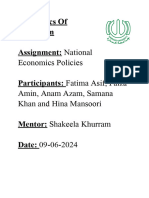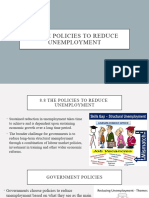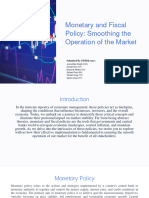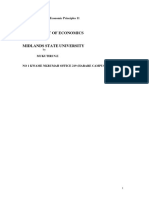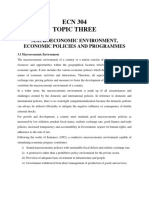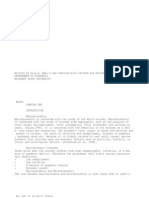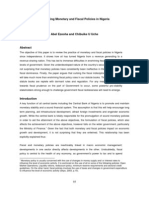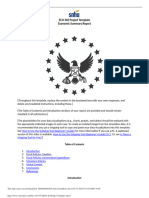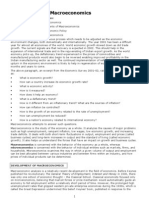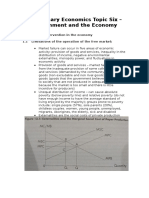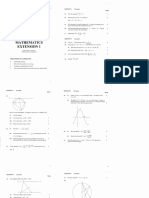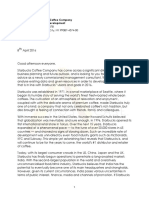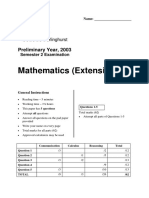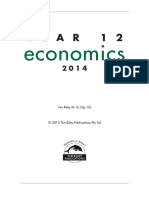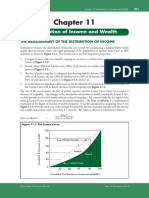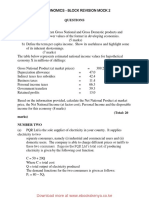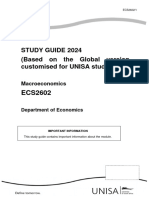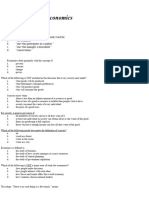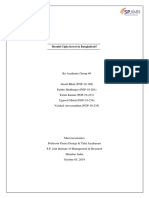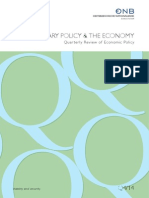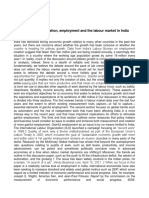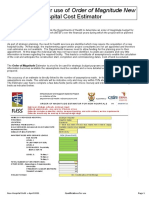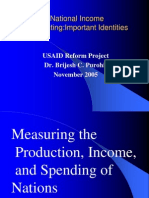2014 Y12 Chapter 13 - CD
2014 Y12 Chapter 13 - CD
Uploaded by
technowiz11Copyright:
Available Formats
2014 Y12 Chapter 13 - CD
2014 Y12 Chapter 13 - CD
Uploaded by
technowiz11Original Title
Copyright
Available Formats
Share this document
Did you find this document useful?
Is this content inappropriate?
Copyright:
Available Formats
2014 Y12 Chapter 13 - CD
2014 Y12 Chapter 13 - CD
Uploaded by
technowiz11Copyright:
Available Formats
ECONOMIC
POLICIES AND
MANAGEMENT
TOPIC FOCUS
This topic focuses on the aims and operation of economic policies in the Australian economy
and hypothetical situations.
Students should learn to examine the following economic issues and apply the following economic
skills in Topic 4 of the HSC course:
Analyse the opportunity cost of government decisions in addressing specific economic
problems or issues;
Investigate structural changes in the Australian economy resulting from microeconomic
policies;
Apply economic theory to explain how a government could address an economic problem or
issue in hypothetical situations; and
Analyse alternative ways to finance a budget deficit.
ECONOMIC SKILLS
Explain how governments are restricted in their ability to simultaneously achieve economic
objectives;
Use simple multiplier analysis to explain how governments can solve economic problems;
Identify limitations of the effectiveness of economic policies;
Explain the impact of key economic policies on the economy;
Propose and evaluate alternative policies to address an economic problem in hypothetical
and the contemporary Australian contexts;
Explain, using economic theory, the general effects of macroeconomic and microeconomic
policies on an economy; and
Select an appropriate policy mix to address a specific economic problem.
The Australian government has three key economic objectives it attempts to achieve. Firstly, it
tries to sustain a rate of economic growth which leads to permanent employment creation, rising
incomes and living standards. Secondly, the internal balance objective consists of trying to
achieve price stability and full employment. Thirdly, external balance is the objective of achieving
a sustainable current account balance, level of net foreign debt, and a stable exchange rate.
The three main policy instruments used by the Australian government to achieve these objectives
are monetary policy, fiscal policy and microeconomic policy. Monetary and fiscal policies can be
used for the stabilisation of aggregate demand and microeconomic policies (including industrial
relations policy) for long term improvements in resource allocation and productivity in the economy.
Tim Riley Publications Pty Ltd
TOPIC FOUR
ECONOMIC ISSUES
Year 12 Economics 2014
276
Chapter 13: Economic Objectives and Policies
277
Economic Growth, Full Employment, Price Stability and External Stability
277
Environmental Sustainability and an Equitable Distribution of Income
279
280
Macroeconomic Policies and the Stabilisation of Aggregate Demand
280
Potential Conflicts among Economic Objectives
Chapter 14: Fiscal Policy
287
The Federal Government Budget
287
Possible Budget Outcomes
288
The Economic Effects of the Budget
292
Recent Trends in Fiscal Policy
301
Chapter 15: Monetary Policy
311
The Goals or Objectives of Monetary Policy
311
The Implementation of Monetary Policy
313
The Economic Impact of Changes in Interest Rates
316
Recent Trends in Monetary Policy
318
Transparency, Accountability and Effectiveness of Monetary Policy
322
Chapter 16: Microeconomic Policy
329
The Rationale for Microeconomic Policies
329
Structural Change and Microeconomic Policies
332
Reforms in Product Markets
333
Reforms in Factor Markets
335
Regulation, Deregulation and Competition Policy
337
The Costs and Benefits of Microeconomic Reform
346
Chapter 17: Labour Market Policy
351
The Role of the National and State Industrial Relations Systems
351
Evolution of the National Industrial Relations System
352
The Role of Institutions in the Current Industrial Relations System
364
Evaluation of the Fair Work Act 2009
Evaluation of the Current Industrial Relations System
367
369
Chapter 18: Australias Recent Economic Performance
377
The Limitations of Economic Policies
377
Australias Recent Economic Performance
380
Glossary and Index
392
Glossary of Terms
392
Index
402
Year 12 Economics 2014
Tim Riley Publications Pty Ltd
Tim Riley Publications Pty Ltd
Chapter 13: Economic Objectives and Policies
Chapter 13
Economic Objectives and Policies
A major rationale for government macroeconomic intervention is to stabilise fluctuations in the business
cycle. This is called the conduct of counter cyclical or stabilisation policy. Fluctuations in the business
cycle occur when economic activity (or real output as measured by changes in real GDP) deviates from
its long run trend, causing excessive levels of inflation in booms, or excessive levels of unemployment
in recessions. The government uses macroeconomic and microeconomic policies to target long term
economic growth which can lead to the achievement of rising living standards and economic prosperity
for Australian residents over time. The three major objectives of government economic policy are:
1. Economic growth which is sustainable in terms of delivering rising real incomes whilst minimising
inflationary pressures and the current account deficit as a percentage of GDP;
2. Internal balance, which refers to the achievement of full employment of resources (including
labour) and price stability where the inflation rate is at or near zero; and
3. External balance, which involves financing import expenditure with export income, stability of the
exchange rate, and the levels of net foreign liabilities and net foreign debt as percentages of GDP.
Other objectives of economic policy include ensuring that the benefits of economic growth are shared
by the majority of the population in terms of a fair or equitable distribution of income and wealth, and
that economic growth is ecologically sustainable in terms of environmental quality being maintained for
current as well as future generations (i.e. intergenerational equity).
ECONOMIC GROWTH AND THE QUALITY OF LIFE
Economic growth involves increasing the economys production of goods and services over time and is
measured by changes in real GDP, which is nominal GDP (or GDP at current prices) adjusted for the
rate of inflation. Sustaining economic growth is important for a number of reasons:
Increases in the rate of economic growth lead to rising real per capita incomes, employment creation
and higher standards of living for the Australian people.
Economic growth is accompanied by an expansion in the economys productive capacity, and
the creation of employment opportunities to accommodate increases in the size of the potential
workforce. This helps to reduce existing levels of unemployment and the rate of unemployment.
Economic growth is consistent with more opportunities for investment in private infrastructure
(such as new plant and equipment), and public infrastructure (such as transport, health and
education), as well as advances in the rate of technological progress, which can all add to the
economys productive capacity and improve the quality of life over time.
Economic growth leads to more opportunities to realise the gains from international trade and
investment through the specialisation of production according to comparative advantage. Higher
rates of economic growth should be accompanied by increased exports and imports and more
opportunities for employment in export industries.
After the release of the Mortimer Report on industry policy (Investing for Growth) in late 1997, the
Australian government committed itself to going for growth by setting a target of 4% real GDP growth
per annum for the Australian economy. This target represented a higher growth outcome than the
historical average of the 3% annual growth rate achieved by Australia between the 1960s and 1980s.
Economic growth averaged 3% to 4% per annum between 1996 and mid 2008. This contributed to a
significant reduction in the unemployment rate from 7% in 1996 to 4.2% by mid 2008. However the
Global Financial Crisis in 2008-09 led to lower growth and a rise in the unemployment rate to 5.8%.
Tim Riley Publications Pty Ltd
Year 12 Economics 2014
277
278
Chapter 13: Economic Objectives and Policies
Tim Riley Publications Pty Ltd
FULL EMPLOYMENT
Full employment refers to the achievement of the objective of full employment of the economys
resources of land, labour, capital and enterprise. In policy terms, full employment is taken to mean
the full employment of the labour force. If the labour force is fully employed, it is assumed that the
other factors of production will also be fully employed. Full employment is defined as that level of
employment where the demand for labour is equal to the supply of labour. However this does not
mean that unemployment will be zero in the labour market as some unemployment will still exist due
to frictional and structural unemployment. This is known as the natural rate of unemployment.
The non accelerating inflation rate of unemployment (NAIRU) is the rate of unemployment that is
consistent with a constant or non accelerating inflation rate. The NAIRU is estimated at 5% to 6% of
the workforce in Australia. This means that if inflation is not increasing (i.e. not accelerating), structural
and frictional factors in the economy would still lead to an unemployment rate of around 5% to 6%.
The government attempts to keep unemployment at the NAIRU by containing inflation and using
reforms in the labour market (such as enterprise bargaining) to reduce the natural rate of unemployment
over time by increasing the flexibility of the labour market and the efficiency and productivity of labour.
The important relationship that exists between economic growth and the rate of unemployment is
known as Okuns Law (developed by the American economist Arthur Okun). Okuns Law states that
the rate of economic growth (e.g. 4%) must exceed the sum of productivity growth (e.g. 2%) and the
growth in the workforce (e.g. 1%), for the unemployment rate to fall (e.g. by -1%) i.e.
Economic Growth
(e.g. 4%)
>
Productivity Growth
(e.g. 2%)
Labour force Growth
(e.g. 1%)
Okuns Law provides the theoretical basis for the Australian government wanting to achieve a growth rate
of around 4% in real GDP in order to reduce the rate of unemployment. If economic growth exceeds
productivity growth plus labour force growth, there should be a fall in the rate of unemployment.
The main benefits of reducing the rate of unemployment include increasing the economys productive
capacity and living standards, and minimising the economic and social costs of unemployment. For
example, during the Global Financial Crisis in 2008-09 the Australian government used expansionary
macroeconomic policies to support economic growth and minimise the rise in the unemployment rate.
PRICE STABILITY
Price stability or low inflation is a major objective of government economic policy because rising inflation
reduces real incomes and living standards. Rising inflation can also cause distortions in the economy
such as a misallocation of resources and a loss in international competitiveness. Rising inflation can
also lead to higher inflationary expectations (i.e. excessive wage and price demands), which can cause a
wage-price spiral to develop in the economy, leading to an acceleration in the rate of inflation.
In the first Statement on the Conduct of Monetary Policy signed by the former Reserve Bank governor Ian
Macfarlane and Treasurer Peter Costello in 1996, a target was set for underlying inflation of 2% to 3%
over the economic cycle. This was formalised as a key operating objective for the conduct of Australias
monetary policy. The underlying rate of inflation is a calculation of inflation that removes one off,
seasonal or volatile factors from the headline or CPI calculation of inflation. However in 1998 changes
to the method used to calculate the CPI by the ABS improved its reliability as a measure of inflation and
the Reserve Bank adopted the CPI measure as its formal target for inflation.
Between 1996 and 2008 inflation was contained by the Reserve Bank and averaged about 2.6% per
annum. Ian Macfarlane was reappointed governor of the Reserve Bank for a further three years in July
2003, and this was contained in the second Statement on the Conduct of Monetary Policy on July 29th
2003 which reaffirmed the Reserve Banks independence in conducting monetary policy and the use of
an inflation targeting regime for the conduct of monetary policy.
Year 12 Economics 2014
Tim Riley Publications Pty Ltd
Tim Riley Publications Pty Ltd
Chapter 13: Economic Objectives and Policies
The third Statement on the Conduct of Monetary Policy was released in 2006 by the former Treasurer, Peter
Costello. Glenn Stevens was appointed as the new governor of the Reserve Bank for a term of seven
years. Inflationary pressures rose between 2006 and 2008 as the economy reached full employment and
capacity constraints emerged, prompting a tightening in monetary policy. However in 2008-09 lower
demand and cost pressures due to the Global Financial Crisis (GFC) led to lower inflation and an easing
in the stance of monetary policy. With economic recovery in the second half of 2009 and early 2010
inflationary pressures rose and the Reserve Bank tightened monetary policy to reduce inflation.
The fourth Statement on the Conduct of Monetary Policy (30th September 2010) reaffirmed the Reserve
Banks use of inflation targeting to conduct monetary policy in a transparent and accountable manner.
A new section was added to the Statement, outlining the Reserve Banks role in using its powers where
appropriate to promote the stability of the Australian financial system, after the turmoil in financial
markets during the GFC. This role was endorsed by Glenn Stevens and the Treasurer, Wayne Swan.
EXTERNAL STABILITY
External stability refers to the goal of Australia meeting its short term and long term financial obligations
with the rest of the world. External stability has three main dimensions or elements:
1. Ensuring that the current account in the balance of payments is in equilibrium. This means that
the income received from exports of goods and services, Australias assets abroad, and transfers,
finances expenditure on imports of goods and services, Australias external liabilities, and transfers.
2. Maintaining stability of the exchange rate in currency markets through international confidence in
the Australian economys performance and the conduct of the governments economic policy.
3. Ensuring that the levels of net foreign liabilities and net external debt are sustainable as percentages
of GDP. The sustainability condition for the current account deficit is that it should be kept to
under -5% of GDP to stabilise net external liabilities and the level of net foreign debt over time.
ENVIRONMENTAL SUSTAINABILITY
Environmental sustainability as an objective of government policy means that current levels of economic
growth and development should meet the needs of the present generation without compromising the
ability of future generations to meet their own needs. This reflects ecologically sustainable development
(ESD) principles by maintaining environmental quality such as clean air and water, and access to other
environmental resources. This can be achieved by meeting environmental standards and preserving
and conserving both renewable and non renewable natural resources. It also commits the Australian
government to meeting its obligations under the Montreal Protocol to reduce CFC emissions; the
Kyoto Protocol to reduce greenhouse gas emissions; various UN environmental treaties (such as the
Antarctic Treaty and the Law of the Sea Treaty), and the World Heritage, Climate Change, Protection
of the Ozone Layer and Biological Diversity global conventions to preserve natural environments.
EQUITABLE DISTRIBUTION OF INCOME
There is not perfect equality in the distribution of income in market economies like Australia because
of differences in the quality and quantity of resources and their factor income returns. However the
government has a social responsibility to redistribute income from high to low income earners to
make the distribution of income more equitable, and to alleviate absolute and relative poverty. The
governments policy objective of achieving a more equitable distribution of income is supported by:
Providing transfer payments to disadvantaged social groups unable to earn market income;
Making the taxation system progressive to redistribute income from high to low income earners;
Using a proportion of taxation revenue to finance spending on elements of the social wage such as
public education, health, transport, housing and community services; and
Reducing the incidence of poverty traps through the selective targeting of welfare assistance.
Tim Riley Publications Pty Ltd
Year 12 Economics 2014
279
280
Chapter 13: Economic Objectives and Policies
Tim Riley Publications Pty Ltd
POTENTIAL CONFLICTS AMONG ECONOMIC OBJECTIVES
In seeking to achieve its economic objectives simultaneously, the Australian government may experience
conflicts or tradeoffs between the main goals of economic policy in both the short and long runs:
Price stability and full employment may conflict with each other in the short run because if the
government pursues policies to promote economic growth and full employment (such as budget
deficits or cuts in interest rates), economic growth may become unsustainable and lead to inflationary
pressures and a lack of price stability. Alternatively, government policies (e.g. budget surpluses or
rises in interest rates) designed to reduce the rate of economic growth and inflation, may lead to
rising unemployment and the governments inability to achieve the objective of full employment.
Economic growth and full employment may conflict with external balance in the short run if an
unsustainable rate of economic growth leads to rising import spending (because of excess aggregate
demand) and a deterioration in the current account of the balance of payments. An unsustainable
current account deficit imposes an external constraint on domestic economic growth and may also
lead to a depreciation in the exchange rate which can raise inflation through higher import prices.
The pursuit of microeconomic efficiency to raise domestic economic growth may conflict in the
long term with full employment as some structural unemployment will result from the structural
changes induced by various microeconomic reform measures. These measures may also conflict
with achieving a more equal distribution of income if displaced workers suffer a loss of income.
Economic growth may conflict with environmental quality in the long run if economic growth is
ecologically unsustainable. This may lead to a depletion of renewable and non renewable resources,
increasing levels of pollution, rising rates of land degradation and a reduction in biodiversity.
MACROECONOMIC POLICIES AND THE STABILISATION OF
AGGREGATE DEMAND
Macroeconomic policies refer to policies directed at stabilising the aggregate level of economic activity
or aggregate demand. The two main tools or instruments of macroeconomic management are fiscal
policy and monetary policy. Fiscal policy refers to the governments use of the federal budget to affect
the level of economic activity, income distribution and resource allocation in the economy. These
fiscal objectives can be achieved through the governments control of the two budgetary instruments
of taxation and government spending. Monetary policy on the otherhand refers to the governments
ability, through its monetary authority, the Reserve Bank of Australia, to affect the level of interest rates
in the economy. Changes in interest rates will indirectly affect the growth and cost of credit, thereby
influencing spending, output, prices and employment in the economy. Monetary policy is generally
used for counter cyclical stabilisation in the economy as it is quicker to implement than fiscal policy.
Macroeconomic policies operate on the demand side of the economy since changes in the settings or
stances of fiscal and monetary policies will impact on the growth of aggregate demand. Changes in
the growth of aggregate demand will then impact on the growth of output (real GDP), employment
and prices. The Australian government may change the settings of macroeconomic policies if the
economys equilibrium level of income does not coincide with the full employment level of income in
the following situations:
If aggregate demand is less than aggregate supply at the full employment level of income, a
deflationary gap may occur in the economy and result in a rise in the rate of unemployment.
If aggregate demand exceeds aggregate supply at the full employment level of income, an inflationary
gap may emerge in the economy and result in a rising price level and inflation.
Both of these situations are illustrated in Figure 13.1. The full employment level of national income
is Y f, where all of the economys resources including labour are fully employed. If the economys
equilibrium level of income is Ye1, aggregate demand (AD1) would be less than the level of spending or
aggregate demand (AD) necessary to achieve the full employment level of income at Yf.
Year 12 Economics 2014
Tim Riley Publications Pty Ltd
Tim Riley Publications Pty Ltd
Chapter 13: Economic Objectives and Policies
Figure 13.1: Macroeconomic Stabilisation of Aggregate Demand
Expenditure
AS
deflationary gap
c
d
a
b
AD2
AD
AD1
inflationary gap
450
Ye1
Yf
Ye2
National Income
A deflationary or unemployment gap of ab would arise causing unemployment to increase. The size
of the deflationary gap is measured by the shortfall in aggregate spending between AD1 and AD. This
could occur if there was a recession such as the Global Financial Crisis in the business cycle in 2008-09.
The government could try to close the deflationary gap of ab by easing the stances of monetary and fiscal
policies to encourage more spending. This would increase aggregate demand from AD1 to AD in Figure
13.1 and could be achieved by using more expansionary settings of monetary and/or fiscal policies:
The government could ease the stance of monetary policy by cutting interest rates in the economy
to encourage consumption and investment spending and the growth in aggregate demand to close
the deflationary gap. Lower interest rates would encourage more borrowing and spending.
The government could adopt a more expansionary stance of fiscal policy (e.g. through a larger
budget deficit or a smaller budget surplus) by cutting taxes and/or increasing government spending
to stimulate aggregate demand. If for example, the economys equilibrium level of income at Ye1
was $1,000m and the full employment level of income at Yf was $1,200m, the government could
increase its level of spending by $100m to close the deflationary gap. Any change in autonomous
government spending (G) will have a multiplier effect (k) on national income (Y). If we assume
a fiscal multiplier of k = 2 then an increase in autonomous government spending (G) of $100m
will lead to an increase in national income (Y) of $200m:
G x k = Y
$100m (G) x 2 (k) = $200m (Y)
Alternatively if the economys equilibrium level of income was Ye2, aggregate demand (AD2) would
exceed the level of spending (AD) necessary to achieve the full employment level of income of Yf. An
inflationary gap of cd would arise causing inflation to increase. The size of the inflationary gap is
measured by the excess of spending between AD2 and AD. This situation could arise if there was a
boom in the business cycle (such as the resources boom between 2006 and 2008) which caused over full
employment and inflation. The government could try to close the inflationary gap of cd by tightening
the settings of monetary and fiscal policies to discourage spending and growth. This would lead to a
decrease in aggregate demand from AD2 to AD in Figure 13.1 and could be achieved by using more
contractionary settings or stances of monetary and/or fiscal policies:
The government could raise interest rates in the economy, to discourage consumption and investment
spending and the growth in aggregate demand, to close the inflationary gap.
The government could adopt a more contractionary stance of fiscal policy by raising taxes and/or
decreasing government spending to reduce the growth of aggregate demand. This may result in a
larger budget surplus (i.e. G < T) or a reduction in the size of an existing budget deficit (i.e. G > T).
Tim Riley Publications Pty Ltd
Year 12 Economics 2014
281
282
Chapter 13: Economic Objectives and Policies
Tim Riley Publications Pty Ltd
ECONOMIC POLICY INSTRUMENTS AND OBJECTIVES
Macroeconomic theory suggests that a government should have at least as many policy instruments as
the number of objectives it is trying to achieve. This is known as the targets and instruments approach
to policy design. If this is the case the government has greater policy flexibility and does not need to
achieve more policy objectives than it has policy instruments. Furthermore, for each instrument there
should be a short term policy target so that the medium or long term objective can be achieved.
Figure 13.2: Economic Policy Instruments and Objectives
Australian Government
Economic Policy Instruments
Monetary Policy
Fiscal Policy
Microeconomic Policy Industrial Relations Policy
Economic Policy Objectives
Internal Balance Economic Growth
External Balance
The Australian government uses a combination of two macroeconomic policy instruments (monetary and
fiscal policies) in the medium term, and one microeconomic policy instrument (in the longer term) to
achieve its three main policy objectives as illustrated in Figure 13.2. These objectives include economic
growth, internal balance and external balance. The Australian government therefore attempts to achieve
three policy objectives with three policy instruments. The next step is to assign each policy instrument
to an objective the government is trying to achieve. This is known as policy assignment. The Howard
government, the Rudd government and the Gillard government used the following policy assignment:
1. Monetary policy is assigned the role of counter cyclical stabilisation through the use of an inflation
target for the conduct of monetary policy by the Reserve Bank. The inflation target is explicitly
stated as 2% to 3% consumer price inflation on average over the economic cycle. The achievement
of the inflation target set by the Reserve Bank and the Treasurer (i.e. in the Statement on the Conduct
of Monetary Policy 2010) is a pre-condition for achieving the other two objectives of economic
growth and full employment.
2. Fiscal policy is largely assigned the role of achieving external balance by ensuring that the budget is
kept in balance over the medium term and that higher public saving (through accumulated fiscal
surpluses) can be used to reduce Australias call on foreign saving. The key relationship is that
the difference between domestic saving and investment is equal to the size of the current account
deficit. Aside from balancing the budget over the medium term, the main fiscal policy target is
keeping the current account deficit to under -5% of GDP over time.
Despite fiscal policy having a more medium term focus in achieving external balance, it can also be
used for counter cyclical stabilisation if economic conditions change. This would involve a more
contractionary fiscal stance if inflationary pressures arose in the economy as they did between 2006
and 2008 due to the resources boom and capacity constraints. Conversely a more expansionary
fiscal stance would be adopted if the rate of economic growth fell and the rate of unemployment
rose as occurred in 2008-09 because of the impact of the Global Financial Crisis and recession.
3. Microeconomic policies have a longer term focus by changing the allocation of resources in the
economy. Microeconomic policies are more effective in promoting structural change or reform in
product and factor markets to make markets more competitive, efficient and productive. Examples
include major reforms in factor markets such as labour market reform and financial deregulation;
and reforms in product markets, such as the reform of tariffs and quotas, and the use of the national
competition policy to maintain competitive conduct by businesses in Australian markets.
Year 12 Economics 2014
Tim Riley Publications Pty Ltd
Tim Riley Publications Pty Ltd
Chapter 13: Economic Objectives and Policies
REVIEW QUESTIONS
ECONOMIC OBJECTIVES AND POLICIES
1. Why does the government use macroeconomic policies to intervene in the economy?
2. Explain the difference between the economic objectives of internal and external balance.
3. Why does the government pursue economic growth as an objective of economic policy?
4. What is meant by full employment? Why does the government pursue the objective of full
employment?
5. What does Okuns Law suggest about the relationship between the rate of economic growth
and the rate of unemployment? What implications does Okuns Law have for the conduct of
Australian economic policy?
6. How and why does the Australian government pursue the objective of price stability?
7. Which three elements are involved in the Australian government achieving external stability?
8. Briefly explain the economic objectives of an equitable distribution of income and ecologically
sustainable development.
9. Discuss the conflicts or tradeoffs that may arise in the short and long runs in the simultaneous
achievement of the Australian governments main economic objectives.
10. Explain how deflationary and inflationary gaps may arise in the economy.
11. How can changes in the settings of macroeconomic policies be used to close deflationary and
inflationary gaps by shifting aggregate demand? Refer to Figure 13.1 in your answer.
12. Discuss the targets and instruments approach to economic policy design in Australia.
13. How are macroeconomic and microeconomic policies assigned to objectives by the Australian
government?
14. Define the following terms and add them to a glossary:
aggregate demand
aggregate supply
deflationary gap
ecologically sustainable development
economic growth
economic objectives
economic policies
efficiency
equitable distribution of income
external balance
fiscal policy
full employment
Tim Riley Publications Pty Ltd
inflationary gap
internal balance
macroeconomic policies
microeconomic policies
monetary policy
natural rate of unemployment
non accelerating inflation rate of unemployment
Okuns Law
price stability
productivity
resource allocation
stabilisation policy
Year 12 Economics 2014
283
284
Chapter 13: Economic Objectives and Policies
Tim Riley Publications Pty Ltd
[CHAPTER 13: SHORT ANSWER QUESTIONS
Year
Real GDP
CPI Inflation
(%r) (%r)
Unemployment Rate Current Account
(% of workforce)
Deficit (% of GDP)
3.5
2.0
5.0
-4.5
4.2
3.5
4.0
-6.0
2.5
2.0
6.0
-4.0
2.1
1.8
6.5
-3.5
1.5
1.6
7.0
-2.8
Refer to the table above of selected economic indicators for a hypothetical economy
and answer the questions below.
Marks
1. What stage of the business cycle did this economy experience in Year 2?
(1)
2. Explain TWO examples of evidence from the table that suggest Year 5 was a period of
low economic activity in this economy.
(2)
3. Describe and account for the relationship between inflation and unemployment between
Years 2 and 5.
(3)
4. Explain how the government of this economy could use a combination of macroeconomic
and microeconomic policies to increase economic activity in Year 5.
(4)
Year 12 Economics 2014
Tim Riley Publications Pty Ltd
Tim Riley Publications Pty Ltd
Chapter 13: Economic Objectives and Policies
[CHAPTER FOCUS ON ECONOMIC OBJECTIVES AND POLICIES
The Objectives, Targets and Instruments of Australian Economic Policy
Objective
Target
Instruments
Price Stability
2% to 3% CPI inflation
over the economic cycle
Monetary and fiscal policies
Full Employment
NAIRU of 5% to 6%
of the workforce
Monetary and fiscal policies
Economic Growth
Sustainable growth of
3% to 4% in real GDP
Monetary and fiscal policies
External Balance
Sustainable current account
deficit of less than -5% of GDP
Monetary and fiscal policies
The maintenance of stable economic conditions in Australia has proven to be a challenging
task, with the emergence of unwanted inflation and external current account pressures. Policy
action to address these and other pressures has frequently contributed to a short term downturn
and inevitably constrained the sustainable pace of economic growth. The source of the problem
however is the policy failure which permitted these pressures to emerge in the first place.
Source: Commonwealth of Australia (1997), Budget Strategy and Outlook 1997-98.
Explain how conflicts or tradeoffs can arise in the Australian governments attempts to achieve its
economic objectives simultaneously.
[CHAPTER 13: EXTENDED RESPONSE QUESTION
Discuss the main economic objectives of the Australian government and explain how it can use
macroeconomic and microeconomic policies to achieve these objectives.
Tim Riley Publications Pty Ltd
Year 12 Economics 2014
285
286
Chapter 13: Economic Objectives and Policies
Tim Riley Publications Pty Ltd
CHAPTER SUMMARY
ECOnomic objectives and policies
1. The major rationale for the use of government counter cyclical or stabilisation policies is to
counteract adverse fluctuations in the business cycle such as higher inflation during booms and
higher unemployment during recessions.
2. The major objectives of Australian government economic policy are to:
Achieve a sustainable rate of economic growth to raise living standards and the quality of life;
Achieve internal balance by securing price stability and full employment of resources; and
Achieve external balance by ensuring export income finances import expenditure, and there
is stability in the level of net foreign liabilities, net foreign debt and the exchange rate.
3. Achieving sustainable economic growth means increasing Australias productive capacity without
adding to inflationary pressures or the current account deficit as a percentage of GDP.
4. Achieving full employment involves minimising the unemployment rate to the NAIRU which is
estimated at between 5% and 6% of the labour force in Australia.
5. Achieving price stability involves the Reserve Bank of Australia meeting its inflation target of 2% to
3% average CPI inflation over the economic cycle.
6. Achieving external balance involves the current account being in equilibrium in the balance of
payments; ensuring that the levels of net foreign liabilities and net foreign debt are sustainable as
a percentage of GDP; and the exchange rate is also stable over time.
7. Other economic objectives of the Australian government include achieving an equitable distribution
of income and environmental sustainability.
8. Conflicts can arise between the simultaneous achievement of the Australian governments economic
objectives. For example, the achievement of sustainable economic growth and full employment
may be compatible in the short run, but could conflict with achieving price stability and external
balance in the long run.
9. Macroeconomic policies such as monetary and fiscal policies are directed at stabilising the growth
of aggregate demand. For example, if an inflationary gap arises in the economy, it can be closed
by the government using a tighter stance of monetary policy to raise interest rates, and fiscal policy
to raise taxes and reduce government spending, to reduce the growth of aggregate demand.
Conversely, if a deflationary gap arises in the economy, it can be closed by the government using
a more expansionary stance of monetary policy to reduce interest rates, and fiscal policy to reduce
taxes and increase government spending, to increase the level of aggregate demand.
10. Microeconomic policies such as tariff reform, the national competition policy and labour market
reform are used by the government to raise productivity, efficiency and international competitiveness
in the economy. Microeconomic policies are directed at the supply side of the economy and have
a long term focus on improving resource allocation and productivity in markets.
11. The use of microeconomic policies complements the use of macroeconomic policies by improving
competition and efficiency, thereby helping the government to achieve its macroeconomic objectives
of sustainable economic growth, price stability, full employment and external balance.
12. A major problem that emerged in the Australian economy between 2005 and 2008 was higher
inflation, whereas in 2008-09 the GFC led to lower economic growth and higher unemployment.
Year 12 Economics 2014
Tim Riley Publications Pty Ltd
You might also like
- Impact of Fiscal Policy On Economic Growth in NigeriaDocument20 pagesImpact of Fiscal Policy On Economic Growth in NigeriaHenry MichealNo ratings yet
- Economics of EducationDocument7 pagesEconomics of Educationdarwaxa5No ratings yet
- 8.8 Govt Policies To Reduce UEDocument5 pages8.8 Govt Policies To Reduce UEMoe LesterNo ratings yet
- Monetary and Fiscal Policy: Smoothing The Operation of The MarketDocument15 pagesMonetary and Fiscal Policy: Smoothing The Operation of The Marketasiacup105No ratings yet
- L8B Introduction To MacroeconomicsDocument19 pagesL8B Introduction To Macroeconomicskurumitokisaki967No ratings yet
- Gov Macroeconmic InterventionDocument58 pagesGov Macroeconmic Interventiontai.mariieeNo ratings yet
- UntitledDocument14 pagesUntitledNaimee PareshaNo ratings yet
- Eco 4Document4 pagesEco 4Nawaz Ali YousufNo ratings yet
- Public Finance IIDocument8 pagesPublic Finance IIBimo Danu PriambudiNo ratings yet
- Essay On Liberalization and Its Impact On The Indian EconomyDocument8 pagesEssay On Liberalization and Its Impact On The Indian EconomyAravind MenonNo ratings yet
- What Is Fiscal Policy?Document10 pagesWhat Is Fiscal Policy?Samad Raza KhanNo ratings yet
- Why Are Economic Objectives Difficult To AchieveDocument17 pagesWhy Are Economic Objectives Difficult To AchieveJackson Black100% (1)
- MacroDocument34 pagesMacroPratik LawanaNo ratings yet
- Economics Principles 11 2023Document130 pagesEconomics Principles 11 2023EnlightenedVirtual SchoolNo ratings yet
- 7.public Finance P4 - UnlockedDocument21 pages7.public Finance P4 - UnlockedGagan Deep SinghNo ratings yet
- Ecn 304 Topic 3Document10 pagesEcn 304 Topic 3olusanyadaniel01No ratings yet
- Fiscal PolicyDocument21 pagesFiscal PolicyDilpreet Singh MendirattaNo ratings yet
- Essay Plans 1: Across The Economy and Thus Stimulate Lending, Borrowing, AD and Economic GrowthDocument24 pagesEssay Plans 1: Across The Economy and Thus Stimulate Lending, Borrowing, AD and Economic GrowthAbhishek JainNo ratings yet
- UntitledDocument44 pagesUntitledHamy MandyNo ratings yet
- 198-Article Text-649-1-10-20230613Document17 pages198-Article Text-649-1-10-20230613divi kayaNo ratings yet
- Fiscal PolicyDocument20 pagesFiscal PolicyPranav VaidNo ratings yet
- Presentation 23261111 PDFDocument12 pagesPresentation 23261111 PDFShaswat BhattacharyaNo ratings yet
- MPL T6 (Group 5)Document19 pagesMPL T6 (Group 5)resourcesficNo ratings yet
- 4.2.2 Types of Fiscal PolicyDocument19 pages4.2.2 Types of Fiscal Policydr7dh8c2sdNo ratings yet
- Corporate Plan: Secretary's Message PurposeDocument10 pagesCorporate Plan: Secretary's Message Purposetiffany!!!No ratings yet
- Fiscal PolicyDocument10 pagesFiscal PolicygyytgvyNo ratings yet
- Macroeconomics CIA 3 2nd SemesterDocument33 pagesMacroeconomics CIA 3 2nd SemesterMeghansh AgarwalNo ratings yet
- Economics Essay Fiscal Policy EffectivenessDocument3 pagesEconomics Essay Fiscal Policy Effectivenessmandeep.agarwalNo ratings yet
- Expansionary and Fiscal Policy Tools To Stabilize The EconomyDocument22 pagesExpansionary and Fiscal Policy Tools To Stabilize The EconomyAndrea Marie O. JadraqueNo ratings yet
- Macroeconomic Objectives NotesDocument2 pagesMacroeconomic Objectives NotesYushreen JambocusNo ratings yet
- Fiscal Policy (ECONOMICS)Document20 pagesFiscal Policy (ECONOMICS)Rajneesh DeshmukhNo ratings yet
- Monetary Policy & Fiscal Policy (2) DDDDDDocument10 pagesMonetary Policy & Fiscal Policy (2) DDDDDepic gamesNo ratings yet
- Budgetary Policy of PakistanDocument8 pagesBudgetary Policy of PakistanJ lodhiNo ratings yet
- Fiscal and Monetary PolicyDocument16 pagesFiscal and Monetary PolicyBezalel OLUSHAKINNo ratings yet
- Rethinking Monetary and Fiscal Policies in NigeriaDocument23 pagesRethinking Monetary and Fiscal Policies in NigeriaTemmy WilliamsNo ratings yet
- Discuss The Various Roles That Fiscal Policy Might Play in The Australian Economy 2Document3 pagesDiscuss The Various Roles That Fiscal Policy Might Play in The Australian Economy 2Dhivyaa Thayalan100% (1)
- Fiscal and Monetary PolicyDocument11 pagesFiscal and Monetary PolicyNahidul IslamNo ratings yet
- EconDocument19 pagesEconkajan thevNo ratings yet
- Makroekonomi OumDocument14 pagesMakroekonomi Oumzakuan79No ratings yet
- Govt Eco Policy Goals - HandoutsDocument10 pagesGovt Eco Policy Goals - Handoutsmuhammadtalhakhan86No ratings yet
- Principles of Economics Ii Assignment QuestionDocument8 pagesPrinciples of Economics Ii Assignment QuestionChristianJerryNo ratings yet
- Conflicts in Governments Objectives (Economics)Document15 pagesConflicts in Governments Objectives (Economics)MarcosNo ratings yet
- Fiscal Policy and Economic GrowthDocument3 pagesFiscal Policy and Economic GrowthGhazouani MohammedNo ratings yet
- Jism Jan14 FiscalDocument16 pagesJism Jan14 FiscalramakntaNo ratings yet
- Economic PolicyDocument4 pagesEconomic Policyecklyne KavuziNo ratings yet
- Activity 1: Economic Security Refers To A Feeling of Freedom and Safety. The People ofDocument4 pagesActivity 1: Economic Security Refers To A Feeling of Freedom and Safety. The People ofAlexis KingNo ratings yet
- Macro Economic Policy InstrumentsDocument11 pagesMacro Economic Policy InstrumentsThankachan CJNo ratings yet
- Fiscal Policy V UNIT-1Document10 pagesFiscal Policy V UNIT-1madhumithaNo ratings yet
- ECO 202 Project Template 3Document5 pagesECO 202 Project Template 3Yo TuNo ratings yet
- Macroeconomics For Professionals Students and Investors A Non Technical CourseDocument286 pagesMacroeconomics For Professionals Students and Investors A Non Technical CoursenishantNo ratings yet
- Fiscal and Monetary Policy: What Is Fiscal Policy?Document7 pagesFiscal and Monetary Policy: What Is Fiscal Policy?sana shahidNo ratings yet
- Lecture 6-1Document17 pagesLecture 6-1Billiee ButccherNo ratings yet
- Lecture 11-Fiscal PolicyDocument8 pagesLecture 11-Fiscal Policyamosmulwanda8765No ratings yet
- Chapter 1 DPB2023Document28 pagesChapter 1 DPB2023anisfazreenaNo ratings yet
- The Effects of Fiscal Operations On Macroeconomic Growth and Stability in NigeriaDocument12 pagesThe Effects of Fiscal Operations On Macroeconomic Growth and Stability in NigeriaMiftahu IdrisNo ratings yet
- Topic 1-NATURE AND SCOPE OF MACROECONOMICSDocument29 pagesTopic 1-NATURE AND SCOPE OF MACROECONOMICSBENTRY MSUKU0% (1)
- Fiscal and Monetary PolicyDocument41 pagesFiscal and Monetary PolicyRavi UdeshiNo ratings yet
- Qa edexcel6EC02Document7 pagesQa edexcel6EC02SaChibvuri JeremiahNo ratings yet
- Session 1 Introduction To MacroeconomicsDocument7 pagesSession 1 Introduction To MacroeconomicsdboterNo ratings yet
- Tutorial Answers - Topic 5: Q1: Mcdonalds (Based On A Past Exam Question)Document8 pagesTutorial Answers - Topic 5: Q1: Mcdonalds (Based On A Past Exam Question)technowiz11No ratings yet
- Preliminary Economics Topic Six - Government and The EconomyDocument6 pagesPreliminary Economics Topic Six - Government and The Economytechnowiz11No ratings yet
- 2007 Baulk Ham Hills YearlyDocument4 pages2007 Baulk Ham Hills Yearlytechnowiz11No ratings yet
- AusCase Case 1 - Starbucks PDFDocument16 pagesAusCase Case 1 - Starbucks PDFtechnowiz11No ratings yet
- 2003 SCEGGS Preliminary 3UDocument7 pages2003 SCEGGS Preliminary 3Utechnowiz11No ratings yet
- 2014 Y12 First Pages - CDDocument6 pages2014 Y12 First Pages - CDtechnowiz11No ratings yet
- 2014 Y12 Chapter 11 - CDDocument16 pages2014 Y12 Chapter 11 - CDtechnowiz11No ratings yet
- HSC Visual Art NotesDocument31 pagesHSC Visual Art Notestechnowiz11No ratings yet
- Gwen Harwood-Poetry Analysis: by Lucas Aoun (Lokzo)Document15 pagesGwen Harwood-Poetry Analysis: by Lucas Aoun (Lokzo)technowiz11No ratings yet
- 2014 Y12 Chapter 5 - CDDocument22 pages2014 Y12 Chapter 5 - CDtechnowiz11No ratings yet
- Material World ObjectivesDocument2 pagesMaterial World Objectivestechnowiz11No ratings yet
- WSJ 2021.12.15Document38 pagesWSJ 2021.12.15Rodrigo MunozNo ratings yet
- ABM - Unit 3 - 1652952854Document1 pageABM - Unit 3 - 1652952854MOHAMED FAROOKNo ratings yet
- Larsen and Toubro Annual Report 2018-2019Document564 pagesLarsen and Toubro Annual Report 2018-2019edgarmerchanNo ratings yet
- Questions Number One: Economics - Block Revision Mock 2Document39 pagesQuestions Number One: Economics - Block Revision Mock 2SamielMuhamedOmarNo ratings yet
- Unit 10 - Lesson 4 - Constructing A Weighted Price IndexDocument17 pagesUnit 10 - Lesson 4 - Constructing A Weighted Price Indexapi-260512563No ratings yet
- Lecture 2 Project Financing & EvaluationDocument116 pagesLecture 2 Project Financing & EvaluationHamis Rabiam MagundaNo ratings yet
- ECS2602 - STUDY GUIDE 2024 - Global Edition - Customised VersionDocument313 pagesECS2602 - STUDY GUIDE 2024 - Global Edition - Customised VersionThemba MkhizeNo ratings yet
- Adjusting Prices For Inflation and Creating Price Indices: FEWS NET Markets Guidance, No 3 May 2009Document23 pagesAdjusting Prices For Inflation and Creating Price Indices: FEWS NET Markets Guidance, No 3 May 2009mazamniaziNo ratings yet
- CIA4U Final Exam ReviewDocument15 pagesCIA4U Final Exam ReviewkolaowlejoshuaNo ratings yet
- Chapter 1 McqsDocument10 pagesChapter 1 Mcqskhanh.taminh061205No ratings yet
- Blanchard Kahn (1980)Document8 pagesBlanchard Kahn (1980)Luis Antonio La Torre QuinteroNo ratings yet
- Essay My GrandmotherDocument3 pagesEssay My Grandmotherdifuw0jisaw3100% (2)
- Practice SetDocument46 pagesPractice Setvs6886No ratings yet
- Money Banking and The Financial System 2nd Edition Hubbard OBrien Test BankDocument32 pagesMoney Banking and The Financial System 2nd Edition Hubbard OBrien Test Banktina100% (37)
- Determinant of Profitability in Indian Cement Industry: An Economic AnalysisDocument15 pagesDeterminant of Profitability in Indian Cement Industry: An Economic AnalysiselchaNo ratings yet
- 40 Bangladesh CiplaDocument9 pages40 Bangladesh CiplaPartho MukherjeeNo ratings yet
- Lipsey Chap.20Document21 pagesLipsey Chap.20Khuzaimah AhmadNo ratings yet
- Mop 2014 q4Document72 pagesMop 2014 q4Bravo TwoZeroNo ratings yet
- BNP FX WeeklyDocument22 pagesBNP FX WeeklyPhillip HsiaNo ratings yet
- Main Japan Port PremiumDocument3 pagesMain Japan Port PremiumTrịnh Huyền LinhNo ratings yet
- Press Release Bank Negara Malaysia Annual Report 2008Document13 pagesPress Release Bank Negara Malaysia Annual Report 2008FarahSillayNo ratings yet
- Econometric Modeling of Consumer Price Indices in Romania Under The Impact of Economic GrowthDocument10 pagesEconometric Modeling of Consumer Price Indices in Romania Under The Impact of Economic GrowthAnamaria PopescuNo ratings yet
- Macroeconomic and Industry AnalysisDocument21 pagesMacroeconomic and Industry Analysismayanksos100% (1)
- Tutorial 5 QuestionsDocument4 pagesTutorial 5 QuestionsĐỗ Minh HuyềnNo ratings yet
- BDocument15 pagesB28- Nguyễn Đức Minh - Chíp PơNo ratings yet
- Assignment 2Document7 pagesAssignment 2SANJEET DHANKHAR 16BEC1300No ratings yet
- 2021 - IUSS - OoM New Hospital Cost EstimatorDocument45 pages2021 - IUSS - OoM New Hospital Cost Estimatorhammoudeh1No ratings yet
- National Income AccountingDocument42 pagesNational Income Accountingraemu26No ratings yet
- Corporate Strategy of Mahindra and MahindraDocument9 pagesCorporate Strategy of Mahindra and MahindraVISHAL DWIVEDINo ratings yet
- Chapter 5: Introduction To Risk, Return, and The Historical RecordDocument6 pagesChapter 5: Introduction To Risk, Return, and The Historical RecordMehrab Jami Aumit 1812818630No ratings yet

